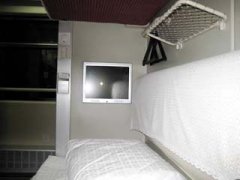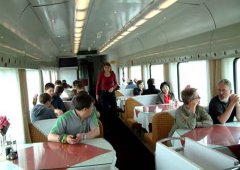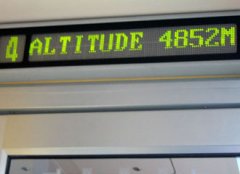Top 20 Tibet Train FAQs: Your Ticket to the World’s Highest Railway Journey to Tibet
Boarding the Qinghai-Tibet Railway, the world's highest railway (averaging 4,500m above sea level), to Tibet has long been one of the ultimate travel bucket lists for global travelers.
If you are preparing for your upcoming Tibet train journey to Tibet and wanna get expert travel advice to maximize your Tibet train journey, we've got you covered.
As the largest local Tibet travel agency receiving 6k+ global travelers to Tibet annually, we've rounded up a list of the top 20 Tibet Train FAQs from international travelers and offer you the best travel solutions for your Tibet train journey.
 1. Where Can I Board the Tibet Train to Lhasa? Preferably from Xining
1. Where Can I Board the Tibet Train to Lhasa? Preferably from Xining
 2. Can I Book Tibet Train Tickets Online? Yes, But Not Recommended
2. Can I Book Tibet Train Tickets Online? Yes, But Not Recommended
 3. What Travel Documents Are Needed to Board the Tibet Train? Tibet Travel Permit Is a Must-have
3. What Travel Documents Are Needed to Board the Tibet Train? Tibet Travel Permit Is a Must-have
 4. Any Jaw-dropping Window Views I Expect to See along the Qinghai-Tibet Railway?
4. Any Jaw-dropping Window Views I Expect to See along the Qinghai-Tibet Railway?
 5. What Is the Best Time to Travel on the Qinghai-Tibet Railway? April to Nov.
5. What Is the Best Time to Travel on the Qinghai-Tibet Railway? April to Nov.
 6. Is It Safe to Travel in Tibet Train? Safe and Secure
6. Is It Safe to Travel in Tibet Train? Safe and Secure
 7. Are There Any Altitude Sickness Precautions on the Tibet Train? Absolutely
7. Are There Any Altitude Sickness Precautions on the Tibet Train? Absolutely
 8. Tibet Train Ride vs Flying to Tibet, Which Is Better for Acclimatization to High Altitude?
8. Tibet Train Ride vs Flying to Tibet, Which Is Better for Acclimatization to High Altitude?
 9. What Are the Classes of Seats Available on the Tibet Train? Go for a Soft Sleeper
9. What Are the Classes of Seats Available on the Tibet Train? Go for a Soft Sleeper
 10. What Can I Eat Aboard Tibet Train? Far More than Boxed Meals
10. What Can I Eat Aboard Tibet Train? Far More than Boxed Meals
 11. Are There Restrooms and Shower Facilities on the Tibet Train?
11. Are There Restrooms and Shower Facilities on the Tibet Train?
 12. How Early Should I Arrive at the Train Station for Check-in? 45min to 1 Hour Earlier
12. How Early Should I Arrive at the Train Station for Check-in? 45min to 1 Hour Earlier
 13. Are There Any Restrictions on Luggage Size or Weight? Yes, But No Worries
13. Are There Any Restrictions on Luggage Size or Weight? Yes, But No Worries
 14. How Much Does It Cost to Travel on the Qinghai-Tibet Railway?
14. How Much Does It Cost to Travel on the Qinghai-Tibet Railway?
 15. Can I Hop off the Tibet Train and Hop back on Days Later with the Same Ticket?
15. Can I Hop off the Tibet Train and Hop back on Days Later with the Same Ticket?
 16. Are there Power Outlets Available for Charging Electronic Devices?
16. Are there Power Outlets Available for Charging Electronic Devices?
 17. Can the Tibet Train Staff Speak English? Not Many
17. Can the Tibet Train Staff Speak English? Not Many
 19. Are There Any Entertainment Provided During the Tibet Train Journey?
19. Are There Any Entertainment Provided During the Tibet Train Journey?
 20. Do I Have Internet Access Aboard the Tibet Train? Yet, But Unstable Due to the Terrain
20. Do I Have Internet Access Aboard the Tibet Train? Yet, But Unstable Due to the Terrain
1. Where Can I Board the Tibet Train to Lhasa? Preferably from Xining
You can board the Tibet train to Lhasa from major cities in China, including Beijing, Shanghai, Guangzhou, Chengdu, Xining, Xi'an, Chongqing, Lanzhou, and more.
However, to enjoy the shortest Tibet train ride while capturing the highlighted views of the Qinghai-Tibet Railway journey, the Xining-Lhasa train is the best Tibet train route you can choose from. It stretches 1,956 kilometers and It takes around 20 hours from Xining to Lhasa by train.
Due to the popularity of the Xining-Lhasa train ticket, it tends to sell out quickly. So, for international tourists, it's advisable to book your Tibet train tickets through your travel agency to maximize your chance of getting the ideal train ticket.
 Xining to Lhasa Railway Map.
Xining to Lhasa Railway Map.
2. Can I Book Tibet Train Tickets Online? Yes, But Not Recommended
Well, theoretically you can book Tibet Train tickets yourself on 12306 China Railway’s official English website and Trip.com.
Yet, in reality, due to the shortage of Tibet train tickets, and more importantly foreign nationals can’t board the Tibet train or flight to Lhasa until you get the Tibet Travel Permit through a pre-booked Tibet tour with a local Tibet travel agency, the best solution is to allow us to help you secure the Tibet train permit to Tibet.
3. What Travel Documents Are Needed to Board the Tibet Train? Tibet Travel Permit Is a Must-have
According to the policy of the Tibet Tourism Bureau, overseas travelers can only visit Tibet through a pre-arranged guided tour with a local Tibet travel agency like us.
You need to show your Tibet Travel Permit applied from your Tibet travel agency, together with your valid passport and Tibet train ticket to board the Qinghai-Tibet Railway to Lhasa. So, it would be a hassle-free solution to rely on us to help you get a Tibet Travel Permit and Tibet train ticket to embark on your Tibet train journey.
 A sample of Tibet Travel Permit for boarding Tibet train.
A sample of Tibet Travel Permit for boarding Tibet train.
4. Any Jaw-dropping Window Views I Expect to See along the Qinghai-Tibet Railway?
Definitely! The highlighted views of the world’s highest train start to unfold after the Tibet train leaves Golmud for Lhasa. In the daytime, you are expected to see:
Qinghai Lake (3,260m): One of the largest and highest saltwater lakes in the world.
Mt. YuZhu (6,178m): Marvel at the stunning vista of snow-capped Youzhu peak, parts of Kunlun Mountain Ranges.
Kekexili Nature Reserve (4,600m): Keep your eyes wide open to spot any Tibetan antelopes, wild yaks, wild asses, alpine foxes, etc. if you are in luck.
Tuotuo River (4,547m): Witness the majestic flow of the Tuotuo River, one of the headwaters of the Yangtze River, meandering through the Tibetan plateau.
Tanggula Mountain Pass (5,068m): This is the highest point on the railway, offering awe-inspiring peaks and dramatic scenery of the Tanggula Mountain Range.
Tsonag Lake (4,600m): Feast your eyes with the serene and one of the highest fresh lakes.
Qiangtang Grassland (4,500m): Enjoy the endless stretches of grassy plains, dotted with Tibetan yaks and nomads' tents in summer.
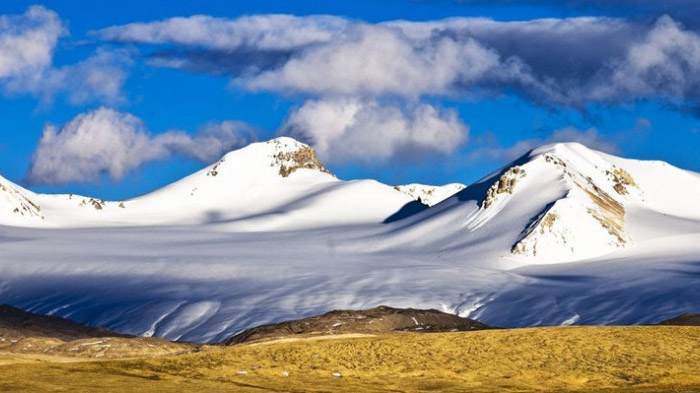 Snow-capped Tanggula Mountains along the Qinghai Tibet Railway.
Snow-capped Tanggula Mountains along the Qinghai Tibet Railway.
5. What Is the Best Time to Travel on the Qinghai-Tibet Railway? April to Nov.
Though the Tibet train journey can be enjoyed all year round, certain times of the year may be more appealing to different travelers.
June to August, though being the high season of Tibet travel, offers you a perfect time to see the grasslands in their full greenery, and glittering alpine lakes and experience the beauty of snow-capped mountains along the Tibet train journey.
April to May and Sept to Oct promise pleasantly mild weather, crisp air, and stunning visibility for trekking, cycling, kora (pilgrimage), etc. You may also combine your Tibet train tour with major Tibetan festivals such as Saga Dawa, and Shoton festivals, to explore the Tibetan traditions.
Starting from November, the off-season for Tibet travel means easier access to soft sleeper tickets along your preferred Tibetan train route. You can enjoy a less crowded Tibet train cabin and wander through the holy Lhsaa city with more pilgrims for an immersive Tibetan experience. Meanwhile, you can book 4-5 star hotels with less money.
6. Is It Safe to Travel in Tibet Train? Safe and Secure
Rest assured that the Tibet train journey is safe and secure. The train staff will patrol the different carriages for security checks and offer help to passengers in need.
Moreover, the Tibet train boasts an air-sealed design and features an oxygen supply system. This ensures passengers remain comfortable even as the train ascends to high altitudes, alleviating any headaches or light-headedness commonly associated with altitude changes.
In addition, the Tibet train will stop longer at certain stations, such as Golmud (25 minutes), to allow you to stretch your legs off the train and have better acclimatization before heading to high stations.
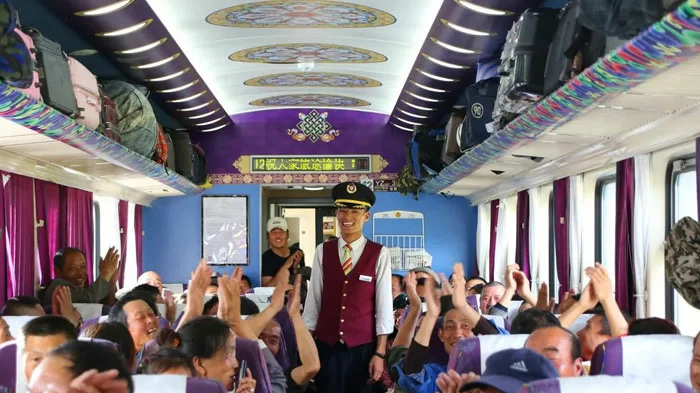 Welcoming and helpful Tibet train staff.
Welcoming and helpful Tibet train staff.
7. Are There Any Altitude Sickness Precautions on the Tibet Train? Absolutely
Definitely! As the world’s highest train, the Tibet train is equipped with an advanced oxygen system. As the train heads to Golmud, the train staff will activate the oxygen supply system, ensuring the safe amount of oxygen level within the carriages.
The train cabins are air-sealed like a plane, protecting you from harsh climate and thin air outside the harsh plateau environment. Additionally, you may easily access the piped-in oxygen through a special socket beside each seat or berth to ease altitude sickness symptoms such as headache, dizziness, fatigue, nausea, etc.
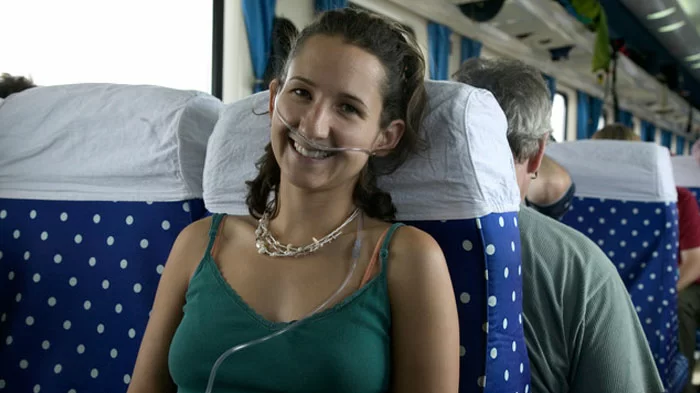 Inhalation of oxygen on the Tibet train.
Inhalation of oxygen on the Tibet train.
8. Tibet Train Ride vs Flying to Tibet, Which Is Better for Acclimatization to High Altitude?
The rumor has it that taking the Tibet train to Lhasa helps better acclimatize to altitude sickness, compared with flying to Tibet. However, the reality is that traveling by train to acclimate to Lhasa’s high altitude only helps a little.
Since the Tibet train carriages are pressured with pumped-in oxygen, it’s pretty similar to traveling on air. Remember, altitude sickness can affect anyone, regardless of your health and fitness level. It has more to do with your natural ability to adapt to high elevation.
While the Tibet train journey does help in acclimatization given the gradual ascent and slower speed than a plane, it's not a guaranteed solution. Many travelers may still experience mild altitude sickness during the journey, such as lightheadedness or dizziness. But, no worries!
9. What Are the Classes of Seats Available on the Tibet Train? Go for a Soft Sleeper
There are three kinds of seats on the Tibet train. For the utmost comfort and privacy, go for the soft sleeper ticket if it is available.
Hard Seat: As the name suggests, a hard seat offers a basic stiff seat for passengers. You will see 98 passengers packed into a single carriage. It’s the most economical option for the Tibet train while sacrificing comfort and privacy.
Hard Sleeper: Hard Sleeper is a mid-range Tibet train ticket. A Hard sleeper carriage can commodate six passengers in bunk beds, with bedding provided in triple-tier bunks. There is a curtain and table available, but there is no door. Do keep any valuables close if you move around the train.
Soft Sleeper: Soft Sleeper is the most comfortable and popular option. Soft sleeper cabins are more spacious and only accommodate four passengers in bunk beds, with TVs available for each passenger and a lockable door for privacy. You may use seated toilets in the bathrooms and a designated place to store your luggage above the door.
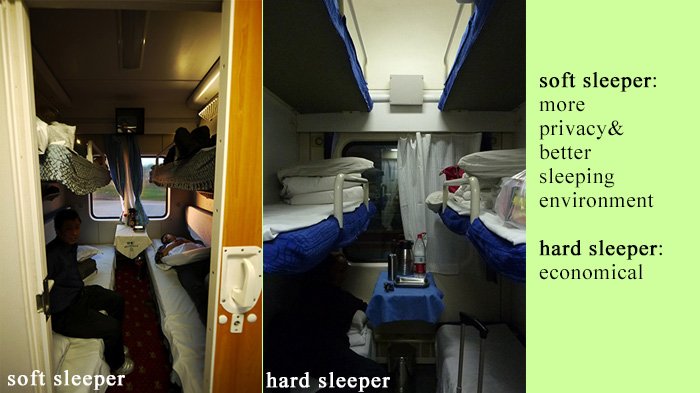 Soft sleeper is more spacious than the hard sleeper in the Tibet train.
Soft sleeper is more spacious than the hard sleeper in the Tibet train.
10. What Can I Eat Aboard Tibet Train? Far More than Boxed Meals
Well, there is a dining carriage on the Tibet train where you can savor traditional Chinese food such as Kung Pao chicken (Spicy chicken with peanuts), Mapo tofu (Spicy tofu with minced meat), Gong Bao shrimp (Spicy shrimp with vegetables), fried rice with various toppings such as egg, vegetables, and meat, tomato egg stir-fry, noodles, etc.
If you don’t want the fuss of going to the dining carriage, during 3 meal times, the staff pulling the food trolley loaded with boxed meals is another option. For breakfast, you can choose from pickles and eggs to bread and milk, which is just 10CNY.
Note that Western cuisines are rarely found on Tibet trains. Besides, you can stock up on small snacks, biscuits, and fruit to enjoy and share with berth mates aboard the Tibet train. Don't forget to bring a thermos bottle to get free boiled water at the dispenser at the end of each carriage.
 Enjoy Chinese food in the dining car of the Tibet train.
Enjoy Chinese food in the dining car of the Tibet train.
11. Are There Restrooms and Shower Facilities on the Tibet Train?
There are two kinds of restrooms in the Tibet train: squat toilets and Western-style (seated) toilets. Do bring your own toilet paper. The sink basins are available at the ends of carriages for general washing up. The showing facilities are not available on the Tibet train.
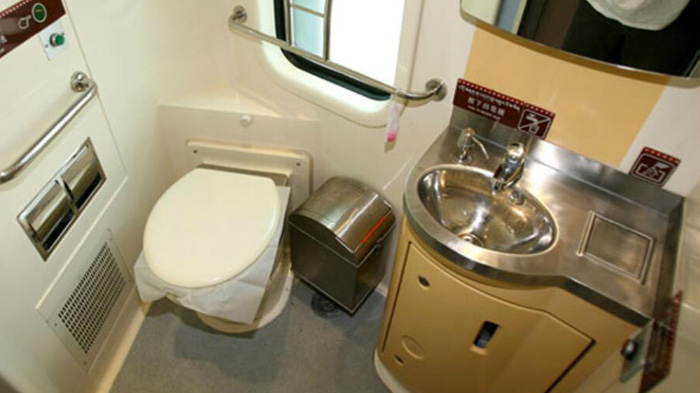 Western style toilet on Tibet train.
Western style toilet on Tibet train.
12. How Early Should I Arrive at the Train Station for Check-in? 45min to 1 Hour Earlier
Usually, there is a long line to board the Tibet train at most train stations, and for foreign nationals, you need to present your Tibet Travel Permit, passport, and train ticket for more security checks. So, do arrive earlier at the station between 45 minutes to 1 hour before the train leaves for Lhasa.
13. Are There Any Restrictions on Luggage Size or Weight? Yes, But No Worries
The maximum limit of free cabin luggage for each passenger is 10 kg for children (including those free of tickets), 35 kg for diplomats, and 20 kg for other passengers.
The maximum dimension of each item is 160 cm in total (rod-shaped items 200 cm) for traditional trains; the maximum weight for each item is 20kg. Foldable wheelchairs used by people with disabilities are not included in the above range.
Daggers, three-edged knives, and explosives are forbidden. Additionally, it's recommended to pack lightly and bring only essential items, as space in the train cabins can be limited.
14. How Much Does It Cost to Travel on the Qinghai-Tibet Railway?
The cost for a Tibet train journey mainly comes from the Tibet train tickets.
Prices for soft sleeper tickets can range from around $150 to $300 or more, depending on the route and season. Besides, If you book a Tibet train ticket from the travel agency, the extra service fee is also expected (300-500 RMB).
The rest is the cost of food on the Tibet train, you can budget $10-15 for daily dining aboard the Tibet train.
15. Can I Hop off the Tibet Train and Hop back on Days Later with the Same Ticket?
Nope! The tickets for Tibet trains are usually issued for specific segments of the journey and have assigned seat or berth numbers. Once you disembark from the train, your ticket is no longer valid for further travel.
If you plan to make multiple stops along your route, you would need to purchase separate tickets for each segment of the journey.
16. Are there Power Outlets Available for Charging Electronic Devices?
Yes, the Tibet train is equipped with power outlets available for you to charge electronic devices. These power outlets are typically located near the seats or berths in the train cabins.
It's a good idea to bring a universal travel adapter with you to ensure compatibility with the power outlets on the train. Additionally, it's recommended to bring a portable power bank when power outlets may be in high demand in a crowded cabin.
17. Can the Tibet Train Staff Speak English? Not Many
Well, some Tibet train staff may have basic English language skills, but English proficiency among train staff can vary. It would be a great idea to use translation apps or Chinese phrasebooks to chat with train staff or birthmates during their Tibet train journey.
18. Can I Book Guided Tibet Train Tours to Lhasa or Extended Tours from Lhasa through the Train Service? Yes
Of course, whether you are traveling to or from Lhasa via Tibet train, you can book a guided tour with us, an award-winning and Lonely Planet-recommended local Tibet travel agency. We can help you secure the Tibet Travel Permit and Tibet train ticket and arrange small group and custom the Tibet tour, Tibet Nepal Buthan tour and China Tibet tours as well. Please feel free to inquire.
19. Are There Any Entertainment Provided During the Tibet Train Journey?
Well, apart from enjoying the amazing window view from the Tibet train, you can watch TV in soft sleepers or chat with fellow travelers during the journey with the help of translation apps, sharing stories, snacks, and experiences.
Alternatively, share photos through Instagram, read your prepared novels, or listen to music or your favorite podcasts. Other than that, there isn’t much public entertainment available on the Tibet train.
20. Do I Have Internet Access Aboard the Tibet Train? Yet, But Unstable Due to the Terrain
Well, free public Wi-Fi is not available on the Tibet train. A great solution is to purchase a local SIM card with data coverage before boarding the train and later use 4G internet access to browse the web.
Note that internet access is unstable as the train passes through long tunnels and remote Tibetan regions along the route.
Conclusion
So, taking the Tibet train to Lhasa is just an iceberg of a bigger and more exciting adventure in Tibet. Hopefully, our informative Tibet train FAQs have sparked your excitement for the journey ahead. If you're hungry for more insights or need expert travel advice, don’t hesitate to email us for a free inquiry. Cheers to your upcoming Tibet train adventure!

Jamyang Tsering, one of our senior travel guides, has a wealth of experience spanning nearly 20 years. Also a celebrated YouTuber for our Tibet Vista channel, Jamyang is genuinely enthusiastic about showing the REAL Tibet to both our customers and fans. It could be an interesting experience to explore Tibet with Jamyang.
Most Popular Tibet Tour Packages
-

Lhasa - Gyantse - Shigatse - Everest Base Camp - Shigatse - Lhasa
USD939
View Details -

Lhasa - Gyantse - Shigatse - E.B.C - Saga - Kailash Trek - Darchen - Lake Manasarovar - Saga - Gyirong - Tingri - Lhasa
USD2059
View Details -

10 Days Lhasa to Everest Base Camp and Namtso Lake Small Group Tour
Lhasa - Gyantse - Shigatse - EBC - Shigatse - Lhasa - Namtso Lake - Damxung - Lhasa
USD1289
View Details -

8 Days Driving Across Himalaya Overland Adventure from Kathmandu to Lhasa
Kathmandu - Gyirong - Everest Base Camp - Tingri - Shigatse - Gyantse - Lhasa
USD1069
View Details -

4 Days Lhasa Impression Small Group Tour: Explore the Heart of Tibet and Mingle with the Locals
Lhasa
USD509
View Details -

Lhasa - Gyantse - Shigatse - Everest Base Camp - Gyirong - Kathmandu
USD979
View Details -

Lhasa - Gyantse - Shigatse- Lhasa
USD799
View Details -

13 Day Lhasa, Mt. Everest, Mt. Kailash, Lake Manasarovar and Kathmandu Adventure Tour
Lhasa - Gyantse - Shigatse - EBC - Saga - Darchen - Kailash Trek - Darchen - Saga - Gyirong - Kathmandu
USD2059
View Details


.jpg)




